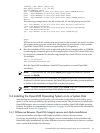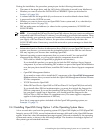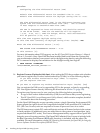Z). The system converts all characters to uppercase, so the case of characters you enter
does not matter.
• Press Enter after you enter the password. (The password does not display as you type
it.)
• After you enter the password, the procedure checks to make sure it meets the
requirements for a valid password.
• Reenter the password for verification.
The following is a sample display:
You must enter a password for the SYSTEM account.
The password must be a minimum of 8 characters in length, and
may not exceed 31 characters. It will be checked and verified.
The system will not accept passwords that can be guessed easily.
The password will not be displayed as you enter it.
Password for SYSTEM account:
Re-enter SYSTEM password for verification:
If you reenter the password incorrectly or if the procedure determines that the password is
too easy for another user to guess, the procedure displays an error message and allows you
to specify a valid password.
10. Declare OpenVMS Cluster Membership: The procedure now asks whether your system
will be part of an OpenVMS Cluster. The display is similar to the following:
Will this system be a member of an OpenVMS Cluster? (Yes/No)
You should answer YES if the system will be a member of an OpenVMS Cluster. Answering
YES to this question causes SYS$MANAGER:CLUSTER_CONFIG.COM to run automatically
when your newly installed system is first booted. The CLUSTER_CONFIG procedure asks
a series of questions about the cluster. Your response to this question determines how the
VAXCLUSTER system parameter is set. (The VAXCLUSTER system parameter is set for
OpenVMS Integrity server systems as well as Alpha and VAX systems; it is not specific to
OpenVMS VAX systems.) For more information, see the Guidelines for OpenVMS Cluster
Configurations manual.
If you answer YES to the cluster question, the display is similar to the following:
When your new system is first booted you will be required to answer
additional questions in order to configure the OpenVMS Cluster.
If you answer NO to the cluster question, the system can still be a member of an OpenVMS
Cluster. However, in this case you must explicitly configure the node into the cluster after
the installation is completed. For more information, see Section 3.6 (page 78).
For more information about cluster configuration, see the HP OpenVMS Cluster Systems
manual.
11. Declaring System as OpenVMS Galaxy Instance (Alpha only): The procedure next asks
whether your system will be an instance in an OpenVMS Galaxy. (This question is asked in
OpenVMS Alpha installations only. OpenVMS Integrity servers does not support OpenVMS
Galaxy.) The display is similar to the following:
Will this system be an instance in an OpenVMS Galaxy? (Yes/No)
Your answer to this question determines how the GALAXY system parameter is set.
12. Set SCSNODE System Parameter: The procedure now asks you to specify a value for the
first of two system parameters, the SCSNODE parameter. (Step 13 describes the output and
prompts for the second system parameter, SCSSYSTEMID.) SCSNODE is a name that can
be from one to six letters or numbers; it must include at least one letter. If this system is part
of an OpenVMS Cluster, SCSNODE must be unique within the cluster. If you are using
3.4 Installing the OpenVMS Operating System on to a System Disk 61


















